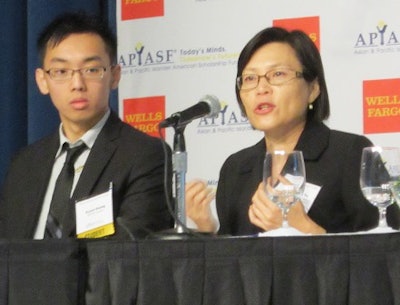 Kyaw Tun Naing, a student at City College of San Francsico and APIASF scholarship recipient, left, and Dr. Minh-Hoa Ta, Dean of City College of San Francisco-Chinatown/North Beach Center participate in the summit.
Kyaw Tun Naing, a student at City College of San Francsico and APIASF scholarship recipient, left, and Dr. Minh-Hoa Ta, Dean of City College of San Francisco-Chinatown/North Beach Center participate in the summit.WASHINGTON — Among the 153 U.S. colleges and universities eligible to become federally designated as Asian-American and Native American Pacific Islander-Serving Institutions (AANAPISIs), only 78 of those schools have sought and been granted the distinction since 2008, when the federal program was launched. Of the 78, just 21 schools have received AANAPISI program funding, which is aimed at improving the retention, transfer and graduation rates of underserved Asian-American and Pacific Islander (AAPI) students.
In a study released Tuesday by the Asian and Pacific Islander American Scholarship Fund (APIASF) and the National Commission on Asian-American and Pacific Islander Research in Education (CARE), the authors explore “baseline data on the federal AANAPISI program to reveal the regional and institutional representation of these colleges and universities along with their student enrollment and degree production,” according to the collaborating organizations.
The study is titled “Partnership for Equity in Education through Research (PEER): Findings from the First Year of Research on AANAPISIs,” and its release coincided with APIASF’s 2013 Higher Education Summit in Washington. With the theme, “Moving Forward: Engaging the Changing Face of America,” the summit drew students, faculty members and college administrators to attend presentations and panel discussions. Neil Horikoshi, the APIASF president and executive director, noted that the organization is celebrating its 10-year anniversary.
APIASF has raised more than $60 million in scholarship funds for underserved Asian-American and Pacific Islander students, he said. Horikoshi explained that similar to scholarship organizations, such as the United Negro College Fund and the Thurgood Marshall College Fund, APIASF has undertaken efforts to help study and help direct assistance to a particular segment of minority-serving institutions.
“I am particularly proud to be in collaboration with Professor Robert Teranishi (and) his entire and wonderful National Commission on Asian-American and Pacific Islander Research in Education team as we begin to present the first finding ever of the Partnership for Equity in Education in Research, also known as the PEER project,” Horikoshi told summit participants.
Teranishi, the CARE principal investigator and associate professor of higher education at New York University, said the baseline data included in the study should enable readers “to get a sense of what institutions are eligible, designated and funded,” and “it gives the demographic profile of the AANAPISI program.”
“The other part of the report has to do with what can we learn from our campus partners around how institutions become AANAPISIs; what does it mean to be an AANAPISI; and what difference that makes for their low-income AAPI students?” Teranishi told Diverse during the APIASF Higher Education Summit.
Among basic findings in the study are the following:
1) Currently, the 21 AANAPISIs with program funding enroll 8.8 percent of the total AAPI enrollment in U.S. higher education and confer 7.6 percent of associate degrees and 5.7 percent of bachelor’s degrees to AAPI students. Designated AANAPISIs reach a much larger concentration of AAPI enrollment (26.9 percent), associate degrees conferred (22.4 percent) and bachelor’s degrees (22.1 percent). And the full cadre of eligible AANAPISIs currently enroll 41.2 percent of all AAPI students and confer 47.3 percent of all associate degrees and 25.3 percent of all bachelor’s degrees.
2) AANAPISI funding has only reached 14 percent of the institutions eligible to be AANAPISIs and 27 percent of the designated institutions. Current budget appropriations for the program do not meet the need or demand, which would require an additional $22.8 million per year over the current level of funding to provide grants to all of the designated AANAPISIs. To fund all eligible AANAPISIs would require an additional $52.8 million per year over the current level of funding.
3) By 2015, another 12 institutions are projected to meet the criteria for being an AANAPISI based on projected enrollment growth among AAPI undergraduate students; however, the projected increase will require an additional $4.8 million in funding needed over the current shortfall of $52.8 million.
APIASF and CARE have been working with three AANAPISI partner schools — City College of San Francisco, De Anza College and South Seattle Community College — on the PEER project. An institution qualifies as an AANAPISI if it has undergraduate enrollment of at least 10 percent Asian-American or Native American Pacific Islander, and at least 50 percent of the student body must be eligible for federal need-based financial assistance.





















